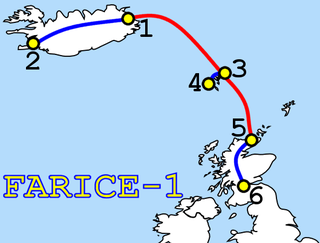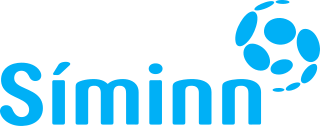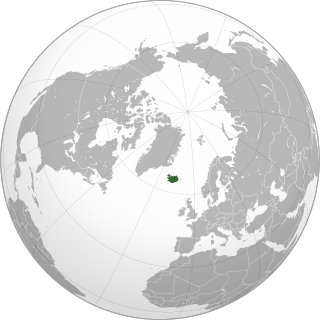Related Research Articles
Nepal's telecommunication network has increased over the years significantly, with the number of telephone users reaching 40,789,198 subscribers as of 14 May 2019.

Telecommunications infrastructure in South Africa provides modern and efficient service to urban areas, including cellular and internet services. The Independent Communications Authority of South Africa (ICASA) is the watchdog of the telecommunications in the country.

CANTAT-3 was the third Canadian transatlantic telecommunications cable, in regular operation from 1994 to 2010, carrying 3 x 2.5 Gbit/s between Canada and Europe. It branches to both Iceland and the Faroe Islands. It is out of normal service for international bandwidth and is currently operated by Føroya Tele to service oil platforms in the North Sea.
Singtel Optus Pty Limited is an Australian telecommunications company headquartered in Macquarie Park, a suburb in the Northern Sydney region of Sydney, New South Wales, Australia. It is a wholly owned subsidiary of Singaporean telecommunications company Singtel.
Ríkisútvarpið (RÚV) is Iceland's national public-service broadcasting organization.

Bharat Sanchar Nigam Limited(abbreviated as BSNL) is a prominent telecommunications company based in India, owned by the Government of India. It operates as a central public sector undertaking with its headquarters in New Delhi, India. BSNL falls under the jurisdiction of the Department of Telecommunications, which is part of the Ministry of Communications, Government of India. The company was established on 1 October 2000 by the Government of India. BSNL provides mobile voice and internet services through its nationwide telecommunications network across India. It is the largest government-owned-wireless telecommunications service provider in India. In 2022, BSNL reported a loss of Rs 57,671 crore since inception.In the financial year 2022-23 it incurred a loss of Rs 6,662 crore.
Nepal Doorsanchar Company Ltd., popularly known as Nepal Telecom or NTC, is a state-owned telecommunications service provider in Nepal with 91.49% of the government share. The company was a monopoly until 2003, when the first private sector operator, United Telecom Limited (UTL), started providing basic telephony services. The central office of Nepal Telecom is located at Bhadrakali Plaza, Kathmandu. It has branches, exchanges and other offices in 184 locations within the country.

FARICE-1 is a submarine communications cable connecting Iceland, the Faroe Islands and Scotland. The cable has been in use since January 2004 and is 100% owned by the Icelandic state. The cable had an initial design capacity of 720 Gbit/s and is a two fibre pair design. The length of the cable is 1205 km for the direct route between Iceland and Scotland. The cable structure and repeaters were made by Pirelli and the terminal equipment was supplied by TYCO. In the year 2013 the terminal equipment was upgraded by Ciena bringing the total capacity of the submarine cable to 11 Tbit/s. The cable has service access points in Reykjavik and Keflavik Airport as well as in London Telehouse East. The company Farice ehf sells services over the FARICE-1 cable. FARICE-2 was never built. DANICE is the complementary submarine cable.

Síminn hf., previously named Landssíminn and Póstur og Sími, is an Icelandic telecommunications company. It offers communication services for both private and corporate clients, including mobile (2G/3G/4G/5G), landline (VoIP/POTS), Internet (ADSL/VDSL/FTTH) and IPTV services. Síminn also operates multiple TV channels and streaming services. Síminn is listed on the Icelandic stock exchange.
Vodafone Iceland is an Icelandic telecommunications company owned by Sýn. Although the company carries the Vodafone brand and trademark, Vodafone Group owns no interest in the company, but rather franchises the brand and associated advertising styles.
Television in Iceland is currently composed of the public broadcasting service of RÚV, five free-to-view channels and a number of subscription channels provided by private broadcasters. Broadcasts began in 1955 when the American Forces Radio and Television Service (AFRTS) started an English-language television service broadcasting from Naval Air Station Keflavik, which operated until 2006. The first Icelandic-language television broadcasts started in September 1966 with the launch of RÚV, originally called Sjónvarpið. In 1986 the first privately owned TV station, Stöð 2, began broadcasts. In recent years the emergence of foreign internet streaming services such as Netflix and Disney+ has seen shift from domestic providers provide similar on demand streaming services such as Síminn Premium and Stöð 2+.

The Internet in South Africa, one of the most technologically resourced countries on the African continent, is expanding. The internet country code top-level domain (ccTLD) .za is managed and regulated by the .za Domain Name Authority (.ZADNA) and was granted to South Africa by the Internet Corporation for Assigned Names and Numbers (ICANN) in 1990. Over 60% of Internet traffic generated on the African continent originates from South Africa. As of 2020, 41.5 million people were Internet users.
Internet access is widely available in New Zealand, with 94% of New Zealanders having access to the internet as of January 2021. It first became accessible to university students in the country in 1989. As of June 2018, there are 1,867,000 broadband connections, of which 1,524,000 are residential and 361,000 are business or government.

Telephone numbers in Iceland are seven digits long and generally written in the form xxx xxxx or xxx-xxxx and the E.123 format specifies +354 xxx xxxx from abroad since the country code is +354.

Iceland is among the top countries in the world in terms of Internet deployment and use. 99.68% of Icelanders used in the internet in 2021.
SHEFA-2 is an undersea communication cable linking the Faroe Islands to mainland Scotland via the Northern Isles. It is named after the route on which it is being deployed (SHEtland-FAroes) and succeeds an earlier cable called SHEFA-1 on the same route.

The DANICE submarine communications cable system transits 2250 km of the North Atlantic Ocean and the North Sea to connect Iceland and Denmark. It consists of four fibre pairs, capable of carrying in total up to 36.4 Tbit/s of data using 100Gbit/s coherent wavelength technology available in 2013. The cable went into operation in November 2009 and has had no submarine faults. The operator of the cable is Farice ehf. The complementary cable is FARICE-1. DANICE has cable landing points at:
Farice is a telecommunications service provider operating in Iceland. The company offers Internet transit, MPLS VPN, DWDM and SDH services and offers only international connectivity. The company operates mainly as a carrier for service providers, data center customers and data center service providers.
Nova, stylised as NOVA, is an Icelandic telecommunications company that began operations on December 1, 2007. Nova owns and operates its own 3G/4G/5G mobile network and offers FTTH fibre internet services through bit-stream access.
Events in the year 1906 in Iceland.
References
- ↑ The Northern Countries In World Economy Denmark Finland Iceland Norway Sweden. Delegations For The Promotion Of Economic Co-operation Between The Northern Countries. 1937. p. 150. Retrieved 25 April 2023.
- ↑ Nafn Skóla. "Saga loftskeyta- og símaþjónustu á Íslandi" (PDF).
- ↑ "Skyggnir felldur - Myndasafn mbl.is". www.mbl.is (in Icelandic). Retrieved 2023-05-24.
- ↑ "Rúmlega 100 ára saga skeytasendinga á enda - RÚV.is". RÚV. 2018-10-01. Retrieved 2023-05-24.
- ↑ www.fjarskiptastofa.is https://www.fjarskiptastofa.is/fjarskiptastofa/stjornsysla/akvardanir-og-urskurdir/akvordun/%C3%9Arlausnir/3-2024 . Retrieved 2024-04-29.
{{cite web}}: Missing or empty|title=(help) - ↑ "Niðurlagning koparheimtaugakerfis Mílu". Míla ehf (in Icelandic). Retrieved 2024-04-29.
- ↑ Electronic Communications Office of Iceland, 2024. (Case no. 2022020045) https://www.eftasurv.int/cms/sites/default/files/documents/gopro/Appendix%20B_Results%20of%20national%20consultation%20on%20markets%20M3ab_Public.pdf
- ↑ Fjarskiptastofa. "Samráð Póst- og fjarskiptastofnunar um úthlutun tíðna fyrir hljóðvarp - FM og DAB".
- ↑ "PFS Tölfræðaskýrsla 2018" (PDF). 1 June 2019.
- ↑ "Landlínukerfið fyrir síma að úreldast". www.mbl.is. Retrieved 2019-06-09.
- ↑ "Heildsala Símans". heildsala.siminn.is. Retrieved 2023-05-24.
- ↑ "Nova launches first 4G network in Iceland". telegeography.com. Retrieved 12 July 2015.
- ↑ "5G-væðingin hafin að fullu – Kortunum fjölgaði úr 119 í tólf þúsund á sex mánuðum". Kjarninn (in Icelandic). 2021-12-19. Retrieved 2022-02-23.
- ↑ "Icelandic 2G network to shut down by end of 2024, 3G by end of 2025". www.telecompaper.com.
